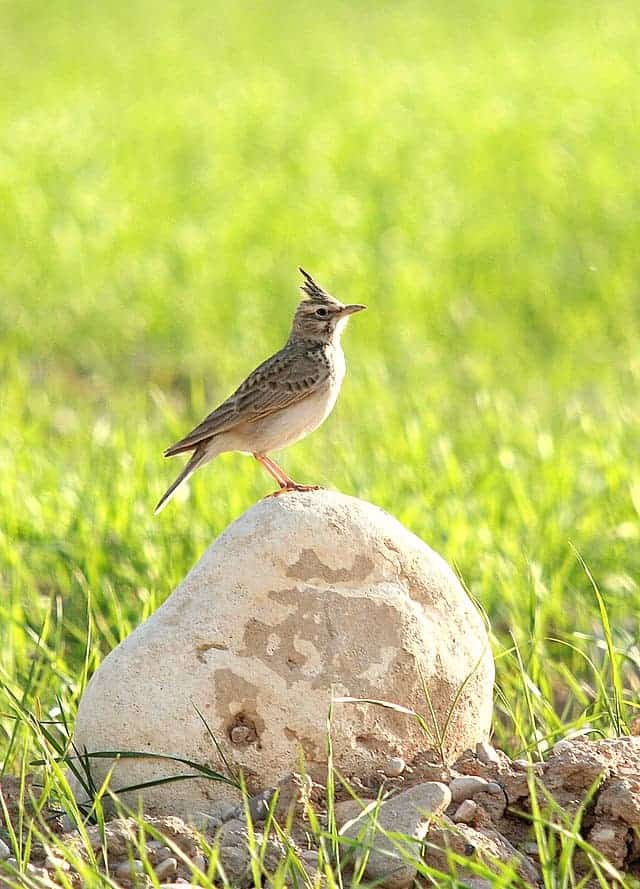Pet owners from a town in Baden-Württemberg, Germany, were told to keep their cats indoors from May 14, or risk substantial fines. The cat lockdown, which just ended, was enforced to protect the local population of the crested lark, a species that’s endangered in Germany.

Cat curfew
People in a part of the town of Walldorf were told that cats can only step outside if they were kept on a leash no more than two meters (6ft) in length. The lockdown, which started in April, ended just this week and will be repeated for the same period for the next three years. Anyone caught breaking the curfew would risk a fine of around $500, and if a cat was caught hunting a crested lark, the fine would go up to over $50,000.
The crested lark (Galerida cristata) is a non-migratory species of lark spread across Eurasia and northern Africa. While some areas still have relatively large populations, the species has been completely extirpated from several countries, and Germany has almost lost its population too — Walldorf has just three breeding pairs.
Officials announced the desperate move to try and protect the few individuals left in the town and support the lark population. The lockdown ended two weeks earlier than expected after town mayor Matthias Renschler said a sufficient number of chicks were able to hatch during the spring.
“I am very pleased that the authorities have acted with a sense of proportion here in view of the current development,” he said. “Of course, the goal remains that this general decree will no longer be necessary in the future,” the mayor added.

But some feel the move was disproportionate. Cats are well-known destroyers of wildlife (in the United States alone, outdoor cats kill approximately 2.4 billion birds every year), but it’s not clear that cats were behind the crested lark problems. The British Royal Society for the Protection of Birds (RSPB) says there is no evidence that attacks from cats in gardens are causing populations to decline, putting most of the blame on agriculture and climate change. For owners who were used to letting their cats roam, the measure was also unpleasant.
Good for the birds, good for the cats
Still, authorities said that roaming cats are a significant source of stress for the crested larks and because the nests were so close to residential areas, the move was appropriate.
“Outdoor cats are one of several factors with regard to the problem of the crested lark,” local authorities said. “But in Walldorf, they are not an insignificant factor due to the proximity to the settlement, which is why measures are also necessary with regard to the cats. Since the crested lark is threatened with extinction, cats pose a particular threat and the measure is suitable, necessary and appropriate.”
A two-year study that tracked roaming cats found that most owned cats have a relatively small range of two hectares (4.9 acres), staying within a kilometer (two-thirds of a mile) from their house. However, if birds were indeed in areas close to residential areas, it’s very likely that the breeding birds (and the helpless chicks, in particular) would have been vulnerable to cats.
While many owners will dislike it, this may have also benefited the cat population. Cats that roam are more likely to get into fights with other cats, catch diseases, or be hit by cars or other vehicles. Simply put, the more a cat roams, the more dangerous its life is.
“Uncontrolled outdoor access is associated with a number of welfare concerns for companion cats, including increased risks of disease and parasites, injury or death due to traffic, predation or ingestion of toxic substances, and getting permanently separated from their owner. In addition, cats pose a threat to local wildlife due to predatory behaviors, and can sometimes be a nuisance to human neighbors,” a 2020 study reads.
Ultimately, this cat lockdown is yet another example of the clash between our beloved cat pets and the wildlife around our homes.
While stray or feral cats do most of the environmental damage, domestic cats can also cause a lot of problems, killing between 6.3 and 22.3 billion mammals annually in the U.S. alone. In the UK, recent figures from the Mammal Society say that cats in the UK catch up to 100 million animals over spring and summer. Last month, a Polish scientific institute also classified domestic cats as an “invasive alien species” due to the damage they do to wildlife. In fact, conservationists consider cats invasive in several parts of the world.
If you want to reduce your roaming cat’s impact, there are a few things you can do. First of all, neutered cats roam far less and are far less aggressive than non-neutered cats. Attaching a small bell to your cat’s collar can help alert its potential prey and prevent the cat from killing birds or small mammals. This would also make it more vulnerable to other large animals such as foxes, but if there are large animals around, you probably shouldn’t let your cat roam at all. You can also invest in a cat enclosure that can let it enjoy the fresh air without being at risk.
If you want to truly reduce the risk, both for wildlife and for your cat, the best thing to do is to not let them roam at all. Although many people believe roaming is healthy for cats, most experts agree that staying indoors is the healthier choice, as they are less exposed to parasites, toxins, predators, and accidents. If you want to strike a balance with roaming, you can use a leash and walk your cat — it may sound strange and it may take some getting used to, but it can help your feline friend enjoy the outdoors safely.









